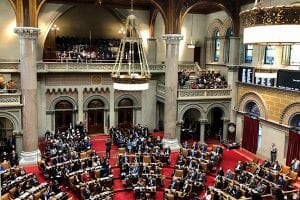25,000 New Housing Units to be Built in Los Angeles
During the height of the pandemic in 2020, homelessness and affordable housing became a hot topic for most states and cities across North America. MBI’s government affairs team utilized this opportunity to connect with decision makers at all levels to promote MBI and the advantages of modular construction.
Several months ago, MBI Government Affairs Director Jon Hannah-Spacagna and MBI Retained Lobbyist Claudia Granados scheduled a Zoom meeting with Los Angeles City Councilman Kevin de León to discuss opportunities for our members and industry to work with the city of Los Angeles to provide much needed housing. According to recent reports, 60% of all homeless adults are located in California.
Councilman de León was presented with a numerous documents and case studies on modular construction as well as examples of affordable housing built by MBI members. The key components of modular construction for the Councilman were the increased speed to complete a project as well as the reduced emissions on the jobsite.
Fast forward to August 10, 2021: the Los Angeles City Council approved a goal of 25,000 units of new housing for homeless people by 2025.

The now-completed Hilda L. Solis Care First supportive housing village in Los Angeles County, built by Crate Modular and VESTA Modular. The project has a total of 232 units, a mess hall, and an administrative building.
Creating—and Following—a “North Star”
Councilman Kevin de León introduced this proposal after spending months saying the city needs a goal — a “North Star” — in its quest to solve the homelessness crisis. He said it was important to create a benchmark for elected officials and the public to assess success and failure. He also said that having a goal would help local government organize itself as it asks the state and federal governments for more help.
The 25,000 units would be a mix of permanent housing and interim non-congregate shelter options — though he didn’t specify the exact breakdown. (Congregate shelters are typical, bunkhouse-style homeless shelters.) Councilman de León, the former leader of the state Senate who is weighing a run for mayor, said purchasing old hotels, building modular units, and master leasing apartments could be some of the ways the city hits the number.
“The time for studying the crisis and hearing from experts, I believe, is over,” de León said. “Now is the time for action and delivering tangible results. Now is the time to get a roof over the heads of our unhoused neighbors and give them an opportunity to regain their lives and restore the pride of a great city.”
“Now is the time for action and delivering tangible results. Now is the time to get a roof over the heads of our unhoused neighbors and give them an opportunity to regain their lives and restore the pride of a great city.”
Los Angeles City Councilman Kevin de León
The City Council asked for reports detailing how the goal could be achieved and what housing finance policies need to be changed to make it happen.
Politicians and voters have been frustrated by the slow opening of housing projects funded by Proposition HHH — the $1.2-billion bond for homeless housing that Los Angeles voters approved more than four years ago. Seven HHH projects have opened in 2021, bringing the total to 804 units, of which 663 are targeted for homeless people. The pace is picking up from one project with 46 units for homeless people in 2019 to six projects and 315 units last year.
A recent report from the California Housing Partnership found that about 500,000 low-income renters don’t have access to affordable housing in Los Angeles County. Its report didn’t break out how many people lack affordable housing in Los Angeles, but it highlights the extreme need in the area.
City research showed that prior to the COVID-19 pandemic, about 41,000 homeless people were within the L.A. city limits. Of them, the Los Angeles Homeless Services Authority estimates about 29,000 live on the streets or in cars. The rest are in shelters or other forms of temporary housing.
Housing, and Lots of It
Councilman Mark Ridley-Thomas, who chairs the Homelessness and Poverty Committee, applauded de León’s goal. He said the success of clearing Venice Beach of tents and getting people into hotels recently occurred because there was money and a detailed plan to make it happen.
“I believe, and I think it’s the intent of the author [de León] to say precisely this: that the best solution is to create more housing, and a lot of it,” Ridley-Thomas said.
But he had a word of a caution and a new task for elected officials: “A goal in and of itself is simply insufficient. We need to have a plan with substantial resources tied to it.”
MBI will continue to work with the city to help them complete their robust housing goals. Additionally, MBI Executive Director Tom Hardiman and Government Affairs Director Jon Hannah-Spacagna have been asked to serve on California’s Housing Advance Planning Group, which will not only utilize modular construction to meet California’s housing needs, but will also actively recruit modular manufacturers to open new factories in the state.
Additional Government Affairs Articles
MBI Works with WA Labor and Industries Dept.
MBI Works with Washington State Labor and Industries Department to Adopt Third Party Plan Reviews At the end of August,…
Read Complete ArticleModular Building Institute Protects Members Doing Business in New York
Modular Building Institute Protects Members Doing Business in New York Early during the 2020 New York State Legislature session, two…
Read Complete ArticleBreaking Down the “Modular Building Code”
MBI often gets calls from people asking, “what is the modular building code?” So, let’s answer that question here.
Read Complete Article

